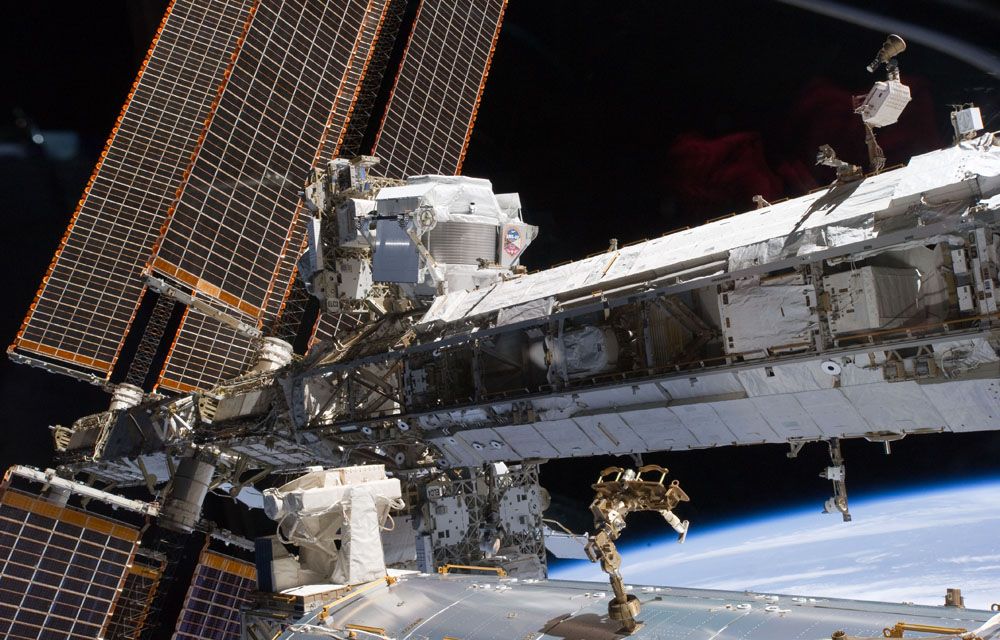NASA Unveiling 1st Results from Antimatter-Hunting Experiment Wednesday

NASA will reveal the first discoveries from a $2 billion antimatter-hunting experiment on the International Space Station on Wednesday (April 2), and you can watch the announcement live online.
Scientists with NASA and the U.S. Department of Energy will unveil the new findings during a 1:30 p.m. EDT (1630 GMT) press conference that will focus on the first science results from the Alpha Magnetic Spectrometer (AMS).
You can watch the AMS discovery announcement live on SPACE.com, courtesy of NASA TV.
"AMS is a state-of-the-art cosmic ray particle physics detector located on the exterior of the International Space Station," NASA officials said in a statement. Scientists are using the spectrometer to delve deeper into the nature of antimatter, dark matter, an invisible substance thought to make up a quarter of the entire universe, and other space mysteries. [See photos of the Alpha Magnetic Spectrometer in space]
Scientists know that every matter particle has an antimatter partner particle with opposite charge; for instance, the antimatter counterpart of an electron is a positron. When matter meets its antimatter counterpart, the two annihilate each other. That annihilation has led to the puzzling prevalence of matter over antimatter in the universe.
NASA officials provided little detail on the exact discoveries to be unveiled on Wednesday, but AMS principal investigator Samuel Ting has dropped some tantalizing clues.
In February, Ting said the first results from the AMS experiment were just weeks away from being released, hinting that scientists would announce a substantial science finding. Ting is a physicist at MIT who received the Nobel Prize for Physics in 1976.
Sign up for the Live Science daily newsletter now
Get the world’s most fascinating discoveries delivered straight to your inbox.
"It will not be a minor paper," Ting said on Feb. 17 during the annual meeting of the American Association for the Advancement of Science in Boston. Ting did not go into detail about the nature of the results, but did say they represent a "small step" toward understanding the true nature of dark matter, even if it is not the final answer.
Several NASA scientists and administrators will take part in tomorrow's briefing. They include:
- William Gerstenmaier, NASA associate administrator for Human Exploration and Operations
- Samuel Ting (participating by video link), AMS principal investigator, Massachusetts Institute of Technology
- Michael Salamon, U.S. Department of Energy Office of Science program manager for AMS
- Mark Sistilli, NASA AMS program manager
The Alpha Magnetic Spectrometer is an international project tested and operated by 56 institutes from 16 different countries. The bus-size detector is managed by NASA's Johnson Space Center in Houston.
Weighing in at a whopping 7 tons, the AMS experiment is one of the most ambitious astrophysics tools ever launched into space.
NASA launched the spectrometer to the International Space Station in May 2011 during the final flight of the space shuttle Endeavour. But the mission almost never came to be.
In 2005, two years after the tragic Columbia space shuttle disaster, NASA canceled the AMS shuttle mission over safety concerns for astronauts. The move sparked a major backlash among the science community that ultimately led to Congress approving funding for an extra space shuttle mission specifically aimed at delivering the AMS experiment to the space station.
This story was provided by SPACE.com, sister site to Live Science. Follow Miriam Kramer @mirikramer and Google+. Follow us @Spacedotcom, Facebook and Google+. Original article on SPACE.com.











